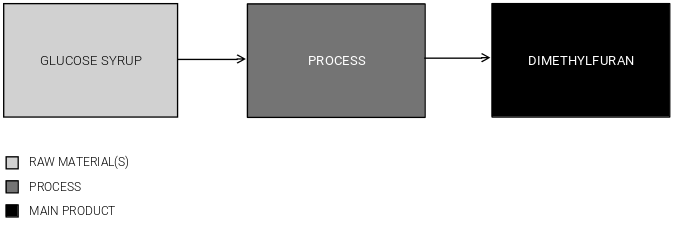Commodity Production Costs Report
Dimethylfuran Production
DMF Plant Capital & Operating Cost Analysis | United States | Q3 2025
This report presents the economics of an early stage process for Dimethylfuran (DMF) production from glucose syrup. The process examined is similar to the one proposed by the University of Wisconsin-Madison. In this process, glucose is isomerized to fructose, which is dehydrated forming hydroxymethylfurfural (HMF) intermediate. Then, HMF is converted to DMF.
The report provides a comprehensive study of DMF production and related DMF production cost, covering three key aspects: a complete description of the DMF production process examined; an in-depth analysis of the related DMF plant capital cost (Capex); and an evaluation of the respective DMF plant operating costs (Opex).
The DMF production process description includes a block flow diagram (BFD), an overview of the industrial site installations, detailing both the process unit and the necessary infrastructure, process consumption figures and comprehensive process flow diagrams (PFD). The DMF plant capital cost analysis breaks down the Capex by plant cost (i.e., ISBL, OSBL and Contingency); owner's cost; working capital; and costs incurred during industrial plant commissioning and start-up. The DMF plant operating costs analysis covers operating expenses, including variable costs like raw materials and utilities, and fixed costs such as maintenance, labor, and depreciation.

Product
Dimethylfuran. DMF (a.k.a. Dimethylfuran) is a heterocyclic compound, and a renewable chemical with a great potential for application as a fuel and fuel additive. It has a high octane number, ideal boiling point, and an energy content similar to that of gasoline. Compared to ethanol, DMF has lower latent heat of vaporization, a lower oxygen content, and is less miscible with water, which favors the processes of purification and distillation. It is also used as a precursor for furan-based compounds presenting several usages as industrial solvents. Production of DMF is based on the hydrogenolysis of 5-hydroxymethylfurfural (HMF), which is obtained via dehydration of C6 sugars, such as glucose and fructose, in the presence of acid catalysts.
Raw Material
Glucose Syrup. Glucose (C6H12O6), also known as D-glucose and dextrose, is the most abundant sugar in nature. Commercial glucose products are available in both dry and syrup forms in a variety of purities and concentrations. Glucose uses include pharmaceuticals, food, chemicals and fuels. This compound is used as raw material in fermentative processes for the production of vitamins, organic acids, antibiotics, amino acids, enzymes, and polysaccharides.
Report in PDF Format
Download & Explore Anytime
Access in Various Devices
Print & Read Comfortably
Share With Co-workers
Up-to-date Report
Professional report based on Q3 2025 economic data, ensuring timely evaluations.
Multiple Use Cases
Ideal for investment screening, feasibility studies, cost estimates, and research planning.
Proven Methodology
Developed using a consistent methodology honed over a decade, ensuring reliable cost analyses.
Report Editions
Content Highlights
Plant Capital Cost Summary
Summary outlining the capital cost required for building the DMF production plant examined.
Plant Capital Cost Details
Detailing of fixed capital (ISBL, OSBL & Owner’s Cost), working capital and additional capital requirements.
Plant Cost Breakdowns
Breakdown of DMF process unit (ISBL) costs and infrastructure (OSBL) costs; plant cost breakdown per discipline.
Operating Costs Summary
Summary presenting the operating variable costs and the total operating cost of the DMF production plant studied.
Operating Cost Details
Detailing of utilities costs, operating fixed costs and depreciation.
Plant Capacity Assessment
Comparative analysis of capital investment and operating costs for different DMF plant capacities.
Production Process Information
Block Flow Diagram, descriptions of process unit (ISBL) and site infrastructure (OSBL).
Process Consumptions
Raw materials and utilities consumption figures, by-products credits, labor requirements
Process Diagrams
Process flow diagrams (PFD), equipment list and industrial site configuration
Could Not Find the Report You Need?
Obtain a Bespoke Report
Get a report targeting the process in which you are interested
See Offer Details
Understand Bespoke Reports and how you can easily order them
Check Editions & Pricing
Complete a brief form and see a quotation for your Bespoke Report
Other Related Production Cost Reports

Glucose Syrup Production
This report presents the economics of Glucose Syrup production from shelled corn. In this process, shelled corn is passed through a wet milling process to recover the corn starch, which, in turn, passes through two subsequent hydrolysis steps for the generation of glucose. The economic analysis performed assumes a plant located in the United States.
Details: 40 kta United States-based plant | Q3 2025 | 107 pages | Issue A | From $799 USD
+800 Reports Developed, Targeting +250 Commodities
Vast Report Library
858 independent and up-to-date reports examining embryonic and established production processes.
Free Sample Reports
Quickly understand the structure and depth of content of our professional reports.

